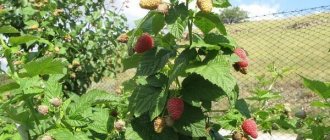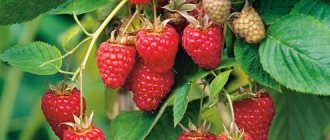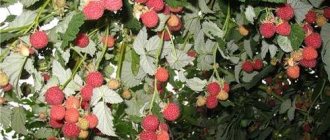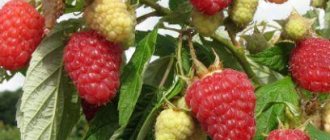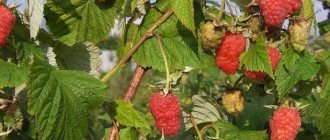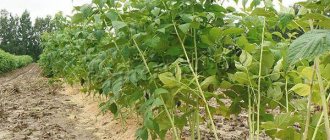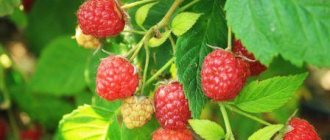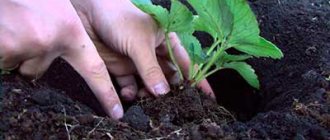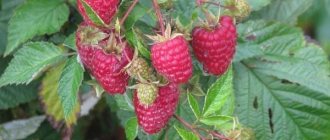Photo and description of Cascade Delight raspberries
The height of the Cascade Delight shrub sometimes exceeds 2.5 m, depending on weather conditions during the growth period. The plant is compact, the root system is powerful and develops well to the sides and in depth.
Botanical description of Cascade Delight:
- The trunk is erect, not spreading. Fruitful branches grow in clusters.
- The thorns are not very developed; there are few of them on the shoots. Moreover, most of them are located at the bottom.
- The leaves are collected in 3-7 alternate, petiolate leaflets, wide at the base and sharp at the end. They are green above and pale green below, slightly pubescent and jagged along the edges. They grow parallel to the ground, which protects the berries from ultraviolet radiation.
- The flowers are 5-petalled, white, collected in tassel inflorescences.
The berries are cone-shaped, bright red and slightly pubescent.
Peculiarity! Quite often there are mosaic-colored fruits, for example, yellow or pink on the sides. This is a feature of the variety, not a disease.
Characteristics of the variety
Cascade Delight is a mid-season variety. With due attention to the crop, it successfully grows and produces harvests in the USA, Great Britain, Ukraine and throughout Russia. Suitable for both private and agro-industrial cultivation.
Main characteristics of the variety:
- not repairable;
- fruiting occurs in the second year of life of the shoots;
- high yield (minimum 4 kg per bush);
- Fruiting lasts 2-4 weeks.
Berries weighing up to 10 g and up to 5 cm in diameter. Their taste is richly sweet, but not cloying, there is sourness. They do not leak, do not crumble, and tolerate transportation and further freezing well. Suitable for mechanical assembly.
Advantages and disadvantages
When breeding the variety, breeders pursued one goal - to increase fruit size and yield. Cascade Delight begins to bear fruit in mid-June.
Other advantages include:
- frost resistance;
- low number of spines;
- resistance to diseases of the root system;
- low crumbling during ripening;
- does not grow in width;
- versatility of fruit use.
Gardeners note its relative unpretentiousness; the main condition is proper planting and proper care in the first year. It is in the first season after planting that Cascade Delight is extremely demanding in terms of pruning, watering and fertilizing. It is also important to choose the right soil for planting.
Other disadvantages include:
- decrease in berry size over time;
- uneven development of the bush;
- susceptibility to certain pests and diseases.
That is, with proper and timely care, the disadvantages of the variety are almost completely eliminated.
Important! The variety is highly drought-resistant, but under the scorching sun without watering, the berries will begin to dry out.
Positive and negative properties
The key advantages of culture include the following characteristics:
- high yield parameters;
- dense pulp;
- large berries;
- long storage period;
- excellent transportability;
- resistance to diseases;
- pleasant taste and aroma;
- easy harvesting;
- versatility of fruit use;
- possibility of cultivation in large farms.
At the same time, the culture also has certain disadvantages that can be minimized with proper care.
The main disadvantages of the plant include the following:
- uneven development of bushes;
- the need for systematic pruning;
- demanding strict adherence to agrotechnical measures;
- mandatory systematic watering, thinning, pruning;
- uneven color of fruits;
- demands on soil composition;
- a gradual decrease in fruit size as the bush ages;
- risk of gray rot or raspberry aphids.
It should be noted that experienced gardeners attribute most of the listed disadvantages to the peculiarities of cultivation.
Landing
Before purchasing Cascade Delight seedlings, you need to take care of choosing the territory in which the raspberry plant will develop. This variety loves fertile soils with an acidity level of pH 5.5 to 6.5. Water should not be allowed to stagnate where raspberries grow, otherwise resistance to root diseases will decrease.
For a raspberry garden, you need to choose a large area, each bush should receive a sufficient amount of sun. You cannot plant Cascade Delight in windward areas.
Preparations for planting begin in the fall. You need to dig up the ground and completely remove the weeds. Fertilizer is also required. The following fertilizing is suitable: 10 kg of compost or humus per 1 sq.m.
Planting of seedlings begins in mid-April, before the buds open. You need to do this:
- Dig trenches or holes measuring 50*50*60. The distance between the rows of raspberries should be at least 1.5 m, and between the bushes you need to maintain at least 1 m.
- You need to put fertilizer in the planting holes (usually mineral ones are chosen).
- Spread the roots of the seedling well and cut off excess shoots. Only 1 main shoot is left.
- Fill with soil up to the root collar and compact.
- Tie the seedling to a trellis or single support.
Next, it remains to water each seedling abundantly, at least 5 liters for each bush.
Interesting! After planting, Cascade Delight should be left to take root on its own. The plant should not be disturbed for 2 weeks. The exception is a dry spring, in which case watering is required.
Landing Cascade Delight
To plant this variety, it is recommended to choose a windless and sunny area with good fertile soil. You can plant seedlings in autumn and spring. It is not recommended to plant raspberries near potatoes, tomatoes, sea buckthorn, currants, and strawberries, as there are common pathogens.
It is good if the soil is loose and allows air and water to pass through. Acidic, clayey soil will not work. It is not recommended to plant if the area is very sandy.
Trenches and holes must be prepared in the fall. Remove weeds from the soil surface and dig up. The depth should be at least thirty centimeters. It is recommended to add two buckets of fertilizer for every square meter.
More on the topic: Harvest raspberry variety Prelest
For example, manure, compost, humus, and so on. If you could not find organic fertilizers, then use fertilizers that contain minerals: potassium sulfate, superphosphate.
When choosing planting material, give preference to seedlings that have a closed root system.
Before planting Cascade Delight, it is necessary to lime the acidic soil.
It is recommended to plant raspberries in rows. Maintain a distance of forty centimeters, and no less than two meters between rows. If your raspberry tree is large enough, then the distance may be greater - 80-90 centimeters.
The hole in which you are going to plant raspberries should be about forty centimeters deep and fifty centimeters wide. The main rule is that the roots must fit completely into the hole.
After planting, the soil must be slightly compacted, watered generously and covered with a layer of dry leaves, humus or peat.
Watering and fertilizing
Watering is carried out at least once a week. If there is no rainy season, then the frequency of watering can be increased.
Cascade Delight also responds well to mulching; the following are suitable for these purposes:
- straw;
- sawdust;
- peat;
- humus.
If you use organic fertilizers as mulch, you do not need to additionally feed the plants. If the area is mulched with straw or sawdust, then fertilizers must be applied at least once every 4 weeks after each watering. Phosphate and potassium fertilizers are suitable.
Peculiarity! The Delight cascade produces its first full harvest in the third year and only if there is sufficient attention to it.
Trimming and tying
Pruning is necessary for the full development of the bush. It is carried out at least three times per season:
- In the spring. Remove dry, damaged shoots. In order to achieve uniform development of the bush, the upper parts of the shoots are cut off by 10-15 cm.
- In autumn. In winter, so that the plant can rest and gain strength, it is cut to 1 m in height.
- In summer. When the main trunk reaches a height of 1 m, it is pinched to allow side shoots to develop.
Each shoot must be tied up. They are fragile and can break under the weight of berries or the wind. The shoots are tied from below and then from above, depending on their growth.
Proper care and cultivation
This variety has a large number of nuances that everyone who wants to get a large amount of high-quality harvest should know. In the first years, the plant grows quite poorly and does not have high yields. Only after three years can Cascade Delight produce an excellent harvest.
Watering
The variety is quite resistant to drought, however, if there is not enough moisture, the quality of the fruit deteriorates significantly. They turn out sour, small, and the plant itself is quite difficult to grow. carry out moderate watering, mulch the soil to retain moisture, carry out constant loosening, no more than ten centimeters deep. This is quite important, because you can damage the root system.
Pruning raspberries Cascade Delight
In the spring, it is necessary to trim dry and damaged shoots, and also shorten them by fifteen centimeters. In the autumn, you need to prune bushes that have a shoot height of approximately one meter.
All shoots that have already borne fruit must be removed. In order for the bush to have good side shoots, you need to pinch the plant in the summer. This procedure is carried out when the bushes have reached a height of one meter.
More on the topic: Raspberry Sputnitsa with traditional berry flavor
Top dressing
If the soil is fertile and you have properly pre-prepared the bush, then the raspberries do not need to be fertilized additionally.
Winter preparation
Bushes need to be covered only in winter, when there is little snow. The variety was tested during mild winters. The plant is not afraid of thick layers of snow and severe frosts.
As a preventive measure, to prepare raspberries for winter, remove leaves that have already fallen. They can be infected with bacteria and disease.
Garter bushes
It is important to tie Cascade Delight using trellises. To do this, install poles at the end and beginning of the rows on which you need to pull the wire.
Preparing for winter
If the winters have little snow, a thin layer of snow will not be able to provide sufficient warmth to the raspberry tree. Therefore, even though Cascade Delight is frost-resistant, it is better to play it safe and prepare for the winter period.
Sequencing:
- The raspberries are watered for the last time.
- Shrubs are trimmed.
- Remove fallen leaves to prevent the development and spread of diseases.
- Cover the ground with agrofibre or peat.
- Cover the insulation with film on top and press it.
After the snow melts, you will need to remove the insulation and loosen the soil.
Protection from diseases and pests
Cascade Delight is resistant to fungal diseases, such as gray rot or anthracnose. But susceptibility to the large crimson aphid and, accordingly, to the dwarf virus, could not be removed. Another problem is root rot, which is extremely rare, provided that the soil drainage is poor.
To avoid and eliminate problems, use the following methods:
- Preliminary check of seedlings and replanting only healthy specimens.
- Properly prepared soil and caring for it. Regular application of fertilizers will protect plants from diseases.
- Regular sufficient watering.
When a disease is detected, you need to react quickly. For example, if a virus infection occurs, it is best to remove the affected elements and burn them.
Description
Cascade Delight is an American variety of summer raspberry with a mid-early ripening period. Fruits on overwintered shoots from last year. Moreover, good growth of the bush and increased yield occurs after reaching 3 years of age. In the south, raspberries begin to bear fruit from the third ten days of June, in the conditions of the Middle Zone, as well as in the west and north of Ukraine - from the second ten days of July. Fruiting is relatively compressed, lasting up to 1 month. When the early varieties have already given up half of the harvest, our hero is just beginning to bear fruit. This makes it possible to extend the berry season and creates a continuous fruit conveyor.
The variety has good growth energy and produces quite a lot of stems, 10-12 pieces per season. The shoots are tall, strong, generally 1.6-2.0 meters high, and with proper agricultural technology they can reach up to 2.5 meters. The shoots are of a semi-standard type, but the bush itself is sloping, the internodes are quite short - this is one of the features of Cascade Delight. The average width of the stems is 1.8−2.0 cm. Young shoots are juicy green in color; by winter they ripen and acquire a brownish-gray tint. During fruiting, shoots may change color to anthocyanin. They are covered with a light waxy coating, without pubescence and with a small number of spines. In this raspberry, the growth of shoots in the first year is no more than 1 meter. The root system of the plant is powerful, the roots are thick and well branched. The spines are small, straight, purple in color. Stems up to a height of 30 cm are densely spiny, the density is 20-40 pieces per 1 linear cm. And already growing, after reaching a height of 1 meter, the density of spines is less than 5 pieces per 1 cm of shoot. Laterals are medium and long, elastic, strong, well branched (2–4 orders of branching). Almost thornless, green, but can acquire an anthocyanin tint.
In the first years of growing Cascade Delight, many gardeners experience problems with the growth of shoots - the bushes seem to sit still. They are squat, stocky, with large leaves and short internodes. Often the main stem is divided into several. One gets the impression that the variety is sick with something. But after several years, the bush gains strength, and the growth energy becomes quite high, the plant produces many long stems. When cultivating raspberries, it is advisable to install a trellis (1.8 meters high) or support. Due to numerous shoots and shortened internodes, plantings are often thickened, and this leads to a deterioration in phytosanitary condition and complicates the collection of berries. Therefore, it is necessary to carry out cutting out excess shoots and regular sanitary cleaning.
The leaves are large, wide, corrugated, ovoid in shape with a sharp nose. Consists of 5 deep green leaves. They are slightly pubescent, with sharply jagged edges. The cloves may acquire a reddish-brown color. The largest leaves are 13 cm long and 8.6 cm wide. They are larger in size than the Meeker and Tulamin varieties. Often the foliage takes on a lemon-lime hue or even becomes simply yellow. What is characteristic is that this color is characteristic not only of young shoots (nettles), but also of fruit-bearing plants. Often, gardeners simply cannot understand what’s wrong with raspberries. It looks like chlorosis in a very strong form. Moreover, this does not affect productivity indicators.
Cascade delight blooms from the third ten days of May. The flowers are collected in numerous, dense, elongated clusters. They are large, 2-2.5 cm wide, white, without a pronounced aroma. A lot of ovaries are formed. The fruits are very beautiful, uniform, even. They are wide, fleshy, elongated - conical in shape. The berries in the first pickings are very large, the average weight is 8.4 grams. A couple of weeks after the start of fruiting, the size becomes somewhat smaller and the average weight is already 5.6 grams. The average length of the fruit in the season is 3.3 cm, width 2.4 cm, but they can grow up to 5 cm in length.
Raspberries are light, bright red, with a slight glossy sheen and slight pubescence. The fruits have a mild whitish coating. The drupes are small, uniform, tightly interconnected. The seeds are small, almost imperceptible when consumed. When harvested, they are removed from the bush without effort, even when not fully ripe, and do not crumble or flow. Another feature of the variety is the heterogeneous, mosaic coloring of some berries. For example, dark red fruits may have lighter, orange-reddish sides.
The fruits have the highest tasting characteristics. They are sweet, but not cloying, with a refreshing, rich raspberry flavor. The berries are elastic, dense, but the pulp is juicy, with a thick raspberry aroma. The levels of sugar and acid are perfectly balanced, and there is a high level of BRIX.
In July 2000, an analysis of raspberry fruits was carried out in Puyallup, Washington, USA, the results are presented in the table.
| Variety name | pH level | Titratable acidity, % | BRIX level, % | Anthocyanins, mg/g |
| Cascade delight | 2,98 | 1,8 | 10,4 | 0,440 |
| Meeker | 3,18 | 1,05 | 11,8 | 0,468 |
| Tulameen | 3,0 | 1,48 | 11,3 | 0,406 |
Transportability and keeping quality of berries are at a high level. These indicators become simply excellent when the fruits are properly cooled. Moreover, transportability is good even for fully ripened berries. Our hero's berries, due to their appearance, size and taste, are highly popular in both wholesale and retail trade. Cascade Delight differs from the reference Tulamin in having longer and thicker shoots, denser and larger fruits and a larger number of drupes.
Fruits of universal use. In addition to direct commercial purposes, they are perfect for fresh consumption, freezing, drying and various types of processing. The jam that comes out is especially wonderful, sweet, aromatic, truly raspberry-flavored. In addition, the berries do not boil in it.
Raspberries have good frost resistance. But slight freezing of the stems and buds is possible. It is advisable to be on the safe side by bending the shoots for the winter, tying them with a pigtail. And in regions with harsh winters, cover bent shoots with agrofibre. In extreme heat, the berries may bake in direct sun. But most of the harvest is hidden under large leaves, which protect the fruits from scorching rays.
Cascade Delight is resistant to a number of major diseases and crop pests. In particular, to anthracnose. Susceptible to the great crimson aphid and the virus it carries. Namely, to the raspberry dwarf virus (RBDV), which spreads among plants through pollen. And also the variety is often damaged by root canker. Prevention - high agricultural background, regular provision of moisture and planting healthy seedlings. In damp, cool weather, fruits may be affected by gray rot. It is often affected by stem gall midge.
Our hero has excellent yield potential. From one bush, depending on agricultural technology, productivity is 4-7 kg. The fruiting zone is up to 70% of the shoot length. The variety is very sensitive to watering. If there is a lack of moisture, the berries lose a lot in size and taste.
To obtain a high yield, regular, balanced nutrition and comprehensive protection from diseases and pests are desirable. Cascade Delight responds positively to the addition of organic matter to the soil. It would not be a bad idea to plow into the soil and mulch raspberry plantings with cut green manure, in particular white or yellow mustard.
Comparative characteristics of varieties based on the results of studies of 6 seasons (from 1995 to 2002).
| Variety name | Cascade delight | Tulameen | Meeker | Willamette |
| Productivity, t/acre | 7,8 | 7,8 | 7,1 | 5,8 |
| Productivity per bush, kg | 3,95 | 3,51 | 3,37 | 3,1 |
| Berry weight, g | 4,90 | 4,06 | 3,24 | 3,27 |
| Rot percentage | 9,8 | 5,6 | 5,9 | 5,1 |
| Berry density, g | 203 | 174 | 180 | 180 |
| 50% collection date | 22nd of June | 21st of June | 21st of June | July 13 |
| Fruiting period, days | 24 | 29 | 26 | 25 |
For research, plants were planted according to the following scheme: 0.9 meters between bushes in a row, row spacing was 2.4 meters. The experiments were conducted by the WSU Puyallup Research Center. To calculate the average weight, 25 berries were randomly selected, weighed, and then the average was calculated. Industrial yields were measured per acre. 1 Acre = 0.4 hectares. Consequently, the yield from 1 hectare is 19.5 tons. And this is with a distance between plants of 0.9 meters. If you plant every 50 cm, the productivity indicators will be almost 2 times higher.
Reproduction methods
Reproduction of Cascade Delight by seeds is impossible under normal conditions. Only breeders can raise new seedlings from seeds.
You can increase the number of plants on a site in several vegetative ways:
- root suckers;
- cuttings;
- dividing bushes.
The simplest method of propagation is digging up and replanting root suckers. They need to be dug up by the roots and transplanted to a new location.
Reviews from gardeners
Gardeners' opinions about Cascade Delight are in most cases positive. The cultivation of the variety is widespread in the central part of the Russian Federation and the Leningrad region. Summer residents like the high yield and taste of raspberries; some note the high energy costs of caring for raspberries.
Evgeniy, St. Petersburg: In our conditions, planting and growing raspberries is quite difficult. St. Petersburg is a rainy city. But Cascade Delight took root with me, and in the second year I already reaped a good harvest!
Tatyana, Moscow: I started developing raspberries in the Moscow region, there are already many varieties, I was interested in Cascade Delight. I planted it last year. I thought it wouldn’t take root - it stayed the same in size. But this year it grew big and produced large berries!
Mikhail, Rostov: The children brought me Cascade Delight seedlings from St. Petersburg, they said that the berries were large and there would be a lot of them. I waited three years, last year I collected at most a bowl. But this year I was pleased! The harvest was a great success, I distributed it to all my neighbors and sent it to my grandchildren, fortunately the berries did not wrinkle.
5 / 5 ( 1 voice )
Planting scheme
When planting raspberries in a row between the bushes, a distance of 0.5–1 m should be maintained, and there should be more space on the sides so that the branches hang freely.
Most often, raspberries are planted in rows.
- Squeezed, compact bushes allow you to minimize the distance between seedlings in a row. On large plantations, planting holes are placed every 30–50 cm. Intensive ribbons are formed.
- On the lands of our garden plots, it is recommended to choose a more spacious scheme, leaving the traditional 70–90 cm between the bushes.
- But the space between the rows must be large - so that the bushes are illuminated from top to bottom. For the high grade Cascade Delight, row spacing is required at least 2.5 meters.
- In small gardens, single-line planting or the bush method is more appropriate. Then the distance between plants can be increased to one and a half meters.
First years of life
Excess, fruit-bearing stems are promptly removed with sharp pruning shears at the root.
At first, young seedlings develop very slowly, atypically, do not immediately show their best side, and disappoint the owner.
This feature is noted by many. It is probably associated with the foreign origin of the Cascade Delight variety. The stranger needs time to adapt to the unusual climate. Fortunately, this berry plant is perennial and quite durable. In the third year, indicators improve.


